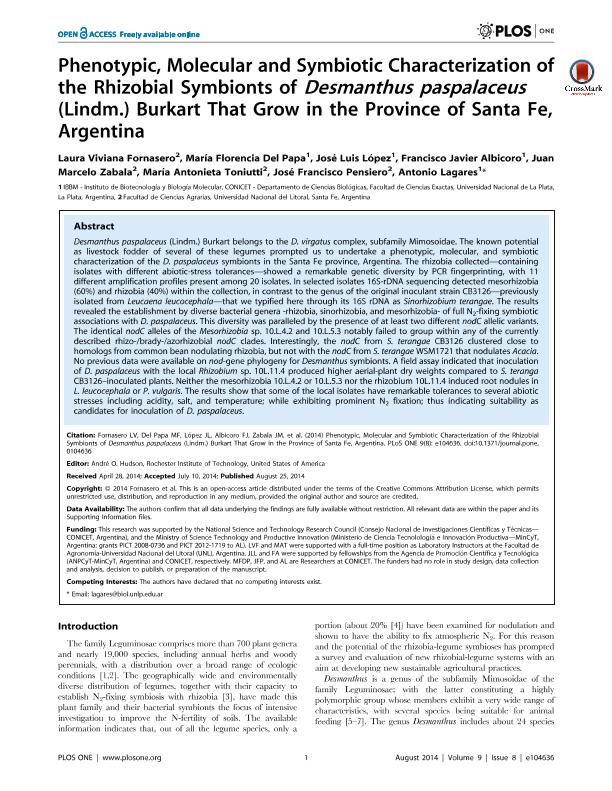Mostrar el registro sencillo del ítem
dc.contributor.author
Fornasero, Laura Viviana

dc.contributor.author
del Papa, Maria Florencia

dc.contributor.author
López, José Luis

dc.contributor.author
Albicoro, Francisco Javier

dc.contributor.author
Zabala, Juan Marcelo

dc.contributor.author
Toniutti, Maria Antonieta

dc.contributor.author
Pensiero, Jose Francisco

dc.contributor.author
Lagares, Antonio

dc.date.available
2017-12-20T15:53:11Z
dc.date.issued
2014-08
dc.identifier.citation
Lagares, Antonio; Pensiero, Jose Francisco; Toniutti, Maria Antonieta; Zabala, Juan Marcelo; Albicoro, Francisco Javier; López, José Luis; et al.; Phenotypic, Molecular and Symbiotic Characterization of the Rhizobial Symbionts of Desmanthus paspalaceus (Lindm.) Burkart That Grow in the Province of Santa Fe, Argentina; Public Library of Science; Plos One; 9; 8; 8-2014; 1-14; e104636
dc.identifier.issn
1932-6203
dc.identifier.uri
http://hdl.handle.net/11336/31110
dc.description.abstract
Desmanthus paspalaceus (Lindm.) Burkart belongs to the D. virgatus complex, subfamily Mimosoidae. The known potential as livestock fodder of several of these legumes prompted us to undertake a phenotypic, molecular, and symbiotic characterization of the D. paspalaceus symbionts in the Santa Fe province, Argentina. The rhizobia collected—containing isolates with different abiotic-stress tolerances—showed a remarkable genetic diversity by PCR fingerprinting, with 11 different amplification profiles present among 20 isolates. In selected isolates 16S-rDNA sequencing detected mesorhizobia (60%) and rhizobia (40%) within the collection, in contrast to the genus of the original inoculant strain CB3126—previously isolated from Leucaena leucocephala—that we typified here through its 16S rDNA as Sinorhizobium terangae. The results revealed the establishment by diverse bacterial genera -rhizobia, sinorhizobia, and mesorhizobia- of full N2-fixing symbiotic associations with D. paspalaceus. This diversity was paralleled by the presence of at least two different nodC allelic variants. The identical nodC alleles of the Mesorhizobia sp. 10.L.4.2 and 10.L.5.3 notably failed to group within any of the currently described rhizo-/brady-/azorhizobial nodC clades. Interestingly, the nodC from S. terangae CB3126 clustered close to homologs from common bean nodulating rhizobia, but not with the nodC from S. terangae WSM1721 that nodulates Acacia. No previous data were available on nod-gene phylogeny for Desmanthus symbionts. A field assay indicated that inoculation of D. paspalaceus with the local Rhizobium sp. 10L.11.4 produced higher aerial-plant dry weights compared to S. teranga CB3126–inoculated plants. Neither the mesorhizobia 10.L.4.2 or 10.L.5.3 nor the rhizobium 10L.11.4 induced root nodules in L. leucocephala or P. vulgaris. The results show that some of the local isolates have remarkable tolerances to several abiotic stresses including acidity, salt, and temperature; while exhibiting prominent N2 fixation; thus indicating suitability as candidates for inoculation of D. paspalaceus.
dc.format
application/pdf
dc.language.iso
eng
dc.publisher
Public Library of Science

dc.rights
info:eu-repo/semantics/openAccess
dc.rights.uri
https://creativecommons.org/licenses/by/2.5/ar/
dc.subject
Rizobios
dc.subject
Paspalaceus
dc.subject
Nodulation
dc.subject
Pgpr
dc.subject.classification
Otras Ciencias Biológicas

dc.subject.classification
Ciencias Biológicas

dc.subject.classification
CIENCIAS NATURALES Y EXACTAS

dc.title
Phenotypic, Molecular and Symbiotic Characterization of the Rhizobial Symbionts of Desmanthus paspalaceus (Lindm.) Burkart That Grow in the Province of Santa Fe, Argentina
dc.type
info:eu-repo/semantics/article
dc.type
info:ar-repo/semantics/artículo
dc.type
info:eu-repo/semantics/publishedVersion
dc.date.updated
2017-12-18T15:05:48Z
dc.journal.volume
9
dc.journal.number
8
dc.journal.pagination
1-14; e104636
dc.journal.pais
Estados Unidos

dc.journal.ciudad
San Francisco
dc.description.fil
Fil: Fornasero, Laura Viviana. Universidad Nacional del Litoral. Facultad de Ciencias Agrarias; Argentina. Consejo Nacional de Investigaciones Científicas y Técnicas. Centro Científico Tecnológico Conicet - Santa Fe; Argentina
dc.description.fil
Fil: del Papa, Maria Florencia. Consejo Nacional de Investigaciones Científicas y Técnicas. Centro Científico Tecnológico Conicet - La Plata. Instituto de Biotecnología y Biología Molecular. Universidad Nacional de La Plata. Facultad de Ciencias Exactas. Instituto de Biotecnología y Biología Molecular; Argentina
dc.description.fil
Fil: López, José Luis. Consejo Nacional de Investigaciones Científicas y Técnicas. Centro Científico Tecnológico Conicet - La Plata. Instituto de Biotecnología y Biología Molecular. Universidad Nacional de La Plata. Facultad de Ciencias Exactas. Instituto de Biotecnología y Biología Molecular; Argentina
dc.description.fil
Fil: Albicoro, Francisco Javier. Consejo Nacional de Investigaciones Científicas y Técnicas. Centro Científico Tecnológico Conicet - La Plata. Instituto de Biotecnología y Biología Molecular. Universidad Nacional de La Plata. Facultad de Ciencias Exactas. Instituto de Biotecnología y Biología Molecular; Argentina
dc.description.fil
Fil: Zabala, Juan Marcelo. Universidad Nacional del Litoral. Facultad de Ciencias Agrarias; Argentina. Consejo Nacional de Investigaciones Científicas y Técnicas. Centro Científico Tecnológico Conicet - Santa Fe; Argentina
dc.description.fil
Fil: Toniutti, Maria Antonieta. Universidad Nacional del Litoral. Facultad de Ciencias Agrarias; Argentina. Consejo Nacional de Investigaciones Científicas y Técnicas. Centro Científico Tecnológico Conicet - Santa Fe; Argentina
dc.description.fil
Fil: Pensiero, Jose Francisco. Universidad Nacional del Litoral. Facultad de Ciencias Agrarias; Argentina. Consejo Nacional de Investigaciones Científicas y Técnicas. Centro Científico Tecnológico Conicet - Santa Fe; Argentina
dc.description.fil
Fil: Lagares, Antonio. Consejo Nacional de Investigaciones Científicas y Técnicas. Centro Científico Tecnológico Conicet - La Plata. Instituto de Biotecnología y Biología Molecular. Universidad Nacional de La Plata. Facultad de Ciencias Exactas. Instituto de Biotecnología y Biología Molecular; Argentina
dc.journal.title
Plos One

dc.relation.alternativeid
info:eu-repo/semantics/altIdentifier/url/http://journals.plos.org/plosone/article?id=10.1371/journal.pone.0104636
dc.relation.alternativeid
info:eu-repo/semantics/altIdentifier/doi/http://dx.doi.org/10.1371/journal.pone.0104636
Archivos asociados
